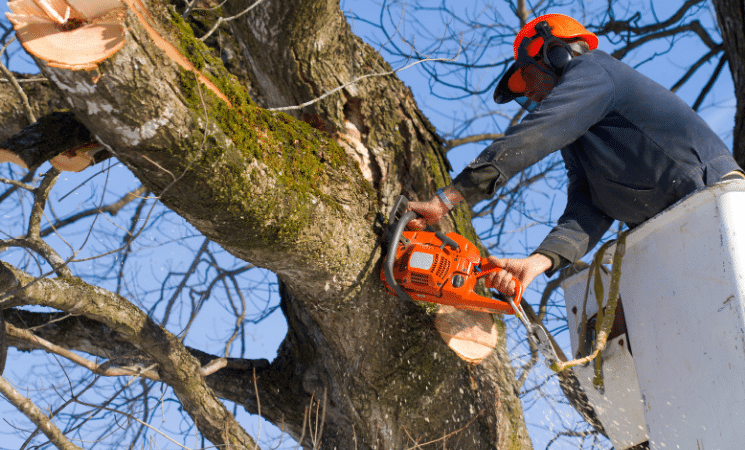
A. The Art of Tree Pruning
Tree pruning is a delicate and precise art that involves the careful removal of specific branches and foliage to enhance the overall health, appearance, and safety of trees to get tree cutting.
B. Significance of Proper Tree Pruning
Proper tree pruning is vital for maintaining the vitality of your trees and the safety of your property. It involves more than just cutting branches; it requires knowledge, skill, and an understanding of tree biology.
C. Understanding Different Types of Pruning
Tree pruning isn’t a one-size-fits-all approach. Different types of pruning serve various purposes, from removing deadwood to shaping the tree’s structure. Understanding these types is crucial for effective tree care.
II. Types of Tree Pruning
A. Crown Cleaning
1. Removing Dead or Diseased Branches
One of the primary goals of crown cleaning is to eliminate branches that are dead, diseased, or infested with pests. This not only improves the tree’s health but also reduces the risk of falling branches.
2. Improving Air Circulation
By removing overcrowded branches, crown cleaning enhances air circulation within the tree’s canopy. This reduces the risk of fungal diseases and promotes overall tree health.
B. Crown Thinning
1. Reducing Density of Foliage
Crown thinning involves selectively removing branches to reduce the density of foliage. This allows more light to penetrate the canopy, benefiting both the tree and the plants beneath it.
2. Enhancing Sunlight Penetration
Increased sunlight penetration through crown thinning encourages photosynthesis and supports the growth of leaves and branches in the upper canopy.
C. Crown Reduction
1. Decreasing Overall Tree Height
Crown reduction is essential for controlling the height and spread of a tree. It is often employed to reduce the risk of storm damage and to prevent interference with structures or power lines.
2. Minimizing Risk of Storm Damage
Reducing the crown’s size reduces the surface area exposed to strong winds during storms, lowering the chances of branch breakage or uprooting.
III. When and How to Prune Trees
A. The Ideal Time for Tree Pruning
1. Dormant Season Pruning
Pruning during the dormant season, typically late winter, is ideal for most tree species. At this time, trees are less stressed, and the absence of leaves provides a clearer view of the tree’s structure.
2. Spring and Summer Pruning
Certain trees, like flowering species, benefit from spring or summer pruning after flowering. However, it’s essential to avoid hot and dry periods to prevent stress to the tree.
B. Proper Pruning Techniques
1. Tools and Equipment
Using the right tools, such as sharp pruning shears and saws, is crucial for clean and precise cuts. Dull or improper tools can damage the tree and slow down healing.
2. Making Clean Cuts
Pruning cuts should be clean and made just outside the branch collar without leaving stubs. Proper techniques help the tree heal faster and reduce the risk of disease.
3. Pruning Guidelines
Adhering to pruning guidelines, including the “one-third rule” (removing no more than one-third of the tree’s canopy), ensures that pruning does not harm the tree’s health.
IV. Benefits of Professional Tree Pruning
A. Healthier Trees
1. Disease Prevention
Regular pruning removes dead or diseased branches, reducing the risk of fungal and bacterial diseases that can spread to the entire tree.
2. Improved Tree Structure
Professional pruning helps develop strong and well-balanced tree structures, reducing the risk of branch breakage.
B. Safety and Property Protection
1. Hazardous Branch Removal
Professional arborists identify and remove hazardous branches that could fall and cause damage or injury.
2. Storm Damage Prevention
Well-pruned trees are more resistant to storm damage, protecting your property during severe weather.
C. Aesthetic Enhancement
1. Shaping and Beauty
Professional pruning enhances the tree’s natural shape and beauty, contributing to a visually appealing landscape.
2. Curb Appeal
A well-pruned tree adds to your property’s curb appeal, increasing its value and attractiveness.
V. Conclusion
A. The Art and Science of Tree Pruning
Tree pruning combines art and science to create healthier, safer, and more beautiful trees.
B. Trusting Professionals for Expert Tree Pruning
For the best results, trust experienced arborists who understand the intricate needs of trees and employ proper pruning techniques.
C. Enhance the Health and Beauty of Your Trees with Proper Pruning
Investing in professional tree pruning not only protects your property but also ensures that your trees thrive for generations to come.


